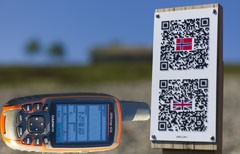GPS-coordinates
N65°40.036′ E011°47.759′ in decimal-minutes N 65°40’02.16» E 011°47’45.54» in minutes and seconds
Figure 1: The intricate structures in front of the mountains Sundsvollhamran, above the cobble-beach at Sundsvoll, quickly catches your attention. Click on the image to download an enlargement of it (may take some time on a mobile). With a little imagination, do you see trolls in it? At the foot of the mountains you see much debris from rock falls, frost-weathered in the escarpment above, deposited into beautiful talus-cones.
The pebble beach at Sundvoll
Just below the signpost you see a » wall» of large boulders towards the sea. These have probably been brought here from the mountain foot opposite the site and serves as a breakwater against the exposed ocean outside (figures 2 and 4). The bedrock and rock constituent in boulders, cobble, and pebble towards the beach is pretty much identical , but the surface of the bedrock is weathered to a dark gray color. You can, however, study the beautiful structures of the local rocks on boulders, beautiful polished by nature (figure 3).
Exercise 1: Classification of rock
Look at some of the largest cobbles and boulders. Can you see mineral grains; small fragments in the rock with equally color, lustre, and hardness? Is the rock solid; with no structures or layering, or can you see structures or layering? Based on these observations try to classify rock type(s). See more about rocks here to help you in your interpretation . Do you see different rocks in different cobbles/boulders or do you see different types of rocks within them? Try to explain how it possibly could be that different rocks are mixed together in the same grain.
Exercise 2: Find beautiful patterns in cobbles and boulders
Inclusions of gneiss-fragments often have a beautiful pattern. If you are a group of people you can have a competition and see who can find the most artistic patterns! My favorite is shown in figure 3, but you can certainly find even more beautiful ones?
Answers
Answers to the questions are found here.
Figure 2: The photo shows a «wall» of boulders that have been removed close to the beach from the mountain foot within, where they have rocked against each other and have became rounded in repeating storms. 
Figure 3: The photo shows a part of a rounded boulder originating from a rock fall. The smoothed surface makes the different structures of the rock visible.
Figure 4: The photo shows the island Søla a mild evening in late May. It consists of granite, identical to the one in this locality.



